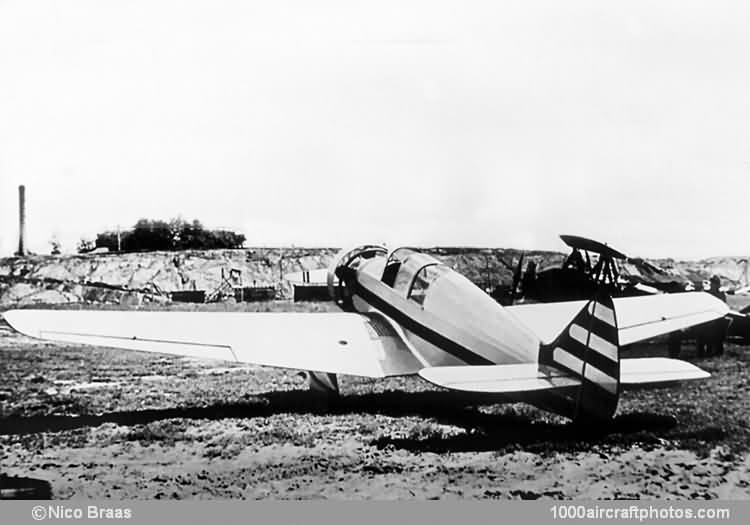11/15/2014. Remarks by Johan Visschedijk: "This two-seat sports aircraft, powered by an 100 hp M-11 engine, was the first machine to be built in the former bed factory to which the Yakovlev design team moved after obtaining the status of an independent organization in January 1934. The AIR-9 was completed in 1934, in time to be exhibited at that year's Paris Air Show.
It was a neat low-wing cantilever monoplane with two seats arranged in tandem under a common canopy with the front hood sliding rearwards over the fixed central portion and the rear hood apparently sliding forward under the fixed section (on some pictures the rear hood has additional framing which suggests that it was sideways-hinged and folding). In its original form this aircraft had a traditional windshield with a rearward-sloping windscreen. Photos show two kinds of this traditional windshield used on the AIR-9. A machine wearing the number '31' (probably a racing number) on the forward fuselage can be seen with a one-piece rounded frameless windshield (it also featured an exhaust collector ring); a differently painted machine carrying no number was shown with a V-shaped windshield formed by flat panels.
The AIR-9's airframe featured wooden two-spar wings attached to a welded-steel center section built integrally with the fuselage. The tail featured the usual duralumin structure with fabric covering; the rudder had a curved trailing edge. The outer wings were tapered and were covered with plywood over the entire upper surface. The wings were fitted with slotted ailerons and large manually operated split flaps. The fuselage was entirely fabric covered, with the exception of the forward portion where a removable hemispherical dome of aluminum covered most of the engine (apart from the cylinder heads). The main landing gear units had lateral and longitudinal bracing struts, the wheels being provided with spats. The AIR-9 was fitted with a standard M-11 driving a two-blade wooden propeller. Initially the AIR-9 had no Townend ring but, when exhibited in Paris in 1934, it was equipped with a Townend ring while retaining the rearward-sloping windshield formed by flat panels.
In 1935 the AIR-9 underwent further modifications. The traditional cockpit windshield was replaced with a V-shaped forward-sloping windscreen. In this configuration (with the Townend ring and the new windscreen) it was designated AIR-9bis. Photos show it to be fitted with an exhaust collector ring. Some sources believe the AIR-9bis to be a conversion of the original prototype, while others assert that this designation applies to a second machine that was allegedly built. Originally the AIR-9bis had a tail skid and wheel spats leaving the landing gear struts exposed. The aircraft was exhibited at the Milan airshow in 1935; there it was shown equipped (temporarily?) with a tail wheel instead of the original leaf-spring tail skid.
In 1937 the AIR-9bis was used for a record flight. On July 4, 1937 the aviatrixes I.N. Vishnevskaya and Ye.M. Mednikova set a women's FAI Class C altitude record of 21,385 ft (6,518 m). For this flight the aircraft was lightened by removing the Townend ring and wheel spats. The record-setting machine had the number '32' on the forward fuselage sides, suggesting its participation in some kind of races. There are photos showing this aircraft, again with the number '32' (before or after the record-breaking flight?), without the Townend ring and, interestingly, with individual exhaust stubs, but with wheel spats and, additionally, the landing gear struts faired by 'trousers'. In all, available pictures show the AIR-9/AIR-9bis in no fewer than six different configurations with regard to power plant, cockpit details, landing gear fairings and color scheme/number, which may well support the theory that more than one example was built."
